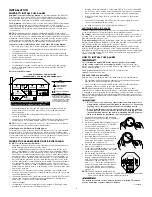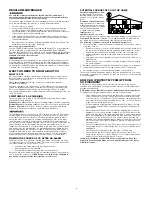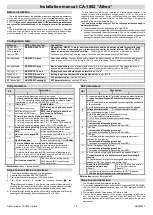
4
REGULAR MAINTENANCE
Use only the replacement batteries listed below. The unit may not
operate properly with other batteries. Never use rechargeable batteries
since they may not provide a constant charge.
This unit has been designed to be as maintenance-free as possible, but there
are a few simple things you must do to keep it working properly:
•
Test it at least once a week.
•
Clean the Smoke/CO Alarm at least once a month; gently vacuum the
outside of the Smoke/CO Alarm using your household vacuum’s soft
brush attachment. Test the Smoke/CO Alarm. Never use water, cleaners or
solvents since they may damage the unit.
•
If the Smoke/CO Alarm becomes contaminated by excessive dirt, dust
and/or grime, and cannot be cleaned to avoid unwanted alarms, replace
the unit immediately.
•
Relocate the unit if it sounds frequent unwanted alarms. See “Where This
Alarm Should Not Be Installed” for details.
Choosing a replacement battery:
Your Smoke/CO Alarm requires one standard 9V battery. The following batter-
ies are acceptable as replacements: Duracell #MN1604, (Ultra) #MX1604;
Eveready (Energizer) #522. You may also use a Lithium battery like the Ultralife
U9VL-J for longer service life between battery changes.
These batteries are
available at many local retail stores.
Actual battery service life depends on the Smoke/CO Alarm and the environ-
ment in which it is installed. All the batteries specified above are acceptable
replacement batteries for this unit. Regardless of the manufacturer’s suggest-
ed battery life, you MUST replace the battery immediately once the unit starts
“chirping” (the “low battery warning”).
WHAT YOU NEED TO KNOW ABOUT CO
WHAT IS CO?
CO is an invisible, odorless, tasteless gas produced when fossil fuels do not
burn completely, or are exposed to heat (usually fire). Electrical appliances
typically do not produce CO.
These fuels include:
Wood, coal, charcoal, oil, natural gas, gasoline,
kerosene, and propane.
Common appliances are often sources of CO. If they are not properly main-
tained, are improperly ventilated, or malfunction, CO levels can rise quickly.
CO is a real danger now that homes are more energy efficient. “Air-tight”
homes with added insulation, sealed windows, and other weatherproofing can
“trap” CO inside.
SYMPTOMS OF CO POISONING
These symptoms are related to CO POISONING and should be discussed
with ALL household members.
Mild Exposure:
Slight headache, nausea, vomiting, fatigue (“flu-like” symptoms).
Medium Exposure:
Throbbing headache, drowsiness, confusion, fast heart rate.
Extreme Exposure:
Convulsions, unconsciousness, heart and lung failure.
Exposure to Carbon Monoxide can cause brain damage, death.
This CO Alarm measures exposure to CO over time. It alarms if CO levels are
extremely high in a short period of time, or if CO levels reach a certain mini-
mum over a long period of time. The CO Alarm generally sounds an alarm
before the onset of symptoms in average, healthy adults. Why is this impor-
tant? Because you need to be warned of a potential CO problem while you
can still react in time. In many reported cases of CO exposure, victims may be
aware that they are not feeling well, but become disoriented and can no
longer react well enough to exit the building or get help. Also, young children
and pets may be the first affected. The average healthy adult might not feel
any symptoms when the CO Alarm sounds. However, people with cardiac or
respiratory problems, infants, unborn babies, pregnant mothers, or elderly
people can be more quickly and severely affected by CO. If you experience
even mild symptoms of CO poisoning, consult your doctor immediately!
FINDING THE SOURCE OF CO AFTER AN ALARM
Carbon monoxide is an odorless, invisible gas, which often makes it difficult
to locate the source of CO after an alarm. These are a few of the factors that
can make it difficult to locate sources of CO:
• House well ventilated before the investigator arrives.
• Problem caused by “backdrafting.”
• Transient CO problem caused by special circumstances.
Because CO may dissipate by the time an investigator arrives, it may be diffi-
cult to locate the source of CO.
BRK Brands, Inc. shall not be obligated to
pay for any carbon monoxide investigation or service call.
POTENTIAL SOURCES OF CO IN THE HOME
Fuel-burning appliances like:
portable heater, gas or wood
burning fireplace, gas kitchen
range or cooktop, gas clothes
dryer.
Damaged or insufficient vent-
ing:
corroded or disconnected
water heater vent pipe, leaking
chimney pipe or flue, or cracked
heat exchanger, blocked or
clogged chimney opening.
Improper use of
appliance/device:
operating a
barbecue grill or vehicle in an enclosed area (like a garage or screened porch).
Transient CO Problems:
“transient” or on-again-off-again CO problems can
be caused by outdoor conditions and other special circumstances.
The following conditions can result in transient CO situations:
1. Excessive spillage or reverse venting of fuel appliances caused by outdoor
conditions such as:
• Wind direction and/or velocity, including high, gusty winds. Heavy air in
the vent pipes (cold/humid air with extended periods between cycles).
• Negative pressure differential resulting from the use of exhaust fans.
• Several appliances running at the same time competing for limited
fresh air.
• Vent pipe connections vibrating loose from clothes dryers, furnaces, or
water heaters.
• Obstructions in or unconventional vent pipe designs which can amplify
the above situations.
2. Extended operation of unvented fuel burning devices (range, oven, fireplace).
3. Temperature inversions, which can trap exhaust close to the ground.
4. Car idling in an open or closed attached garage, or near a home.
These conditions are dangerous because they can trap exhaust in your home.
Since these conditions can come and go, they are also hard to recreate during
a CO investigation.
HOW CAN I PROTECT MY FAMILY FROM
CO POISONING?
A CO Alarm is an excellent means of protection. It monitors the air and
sounds a loud alarm before Carbon Monoxide levels become threatening for
average, healthy adults.
A CO Alarm is not a substitute for proper maintenance of home appliances.
To help prevent CO problems and reduce the risk of CO poisoning:
• Clean chimneys and flues yearly. Keep them free of debris, leaves, and
nests for proper air flow. Also, have a professional check for rust and
corrosion, cracks, or separations. These conditions can prevent proper
air movement and cause backdrafting. Never “cap” or cover a chimney
in any way that would block air flow.
• Test and maintain all fuel-burning equipment annually. Many local gas
or oil companies and HVAC companies offer appliance inspections for
a nominal fee.
• Make regular visual inspections of all fuel-burning appliances. Check
appliances for excessive rust and scaling. Also check the flame on the
burner and pilot lights. The flame should be blue. A yellow flame means
fuel is not being burned completely and CO may be present. Keep the
blower door on the furnace closed. Use vents or fans when they are
available on all fuel-burning appliances. Make sure appliances are vent-
ed to the outside. Do not grill or barbecue indoors, or in garages or on
screen porches.
• Check for exhaust backflow from CO sources. Check the draft hood on
an operating furnace for a backdraft. Look for cracks on furnace heat
exchangers.
• Check the house or garage on the other side of shared wall.
• Keep windows and doors open slightly. If you suspect that CO is
escaping into your home, open a window or a door. Opening windows
and doors can significantly decrease CO levels.
In addition, familiarize yourself with all enclosed materials. Read this
manual in its entirety, and make sure you understand what to do if your
CO Alarm sounds.
























